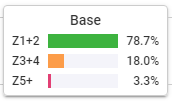Xert is a strain based model comprised of low, high, and peak strain.
Polarity Ratio – Xert (baronbiosys.com)
The net effect is a hybrid polarized approach as explained in this article –
Sweet Spot, Threshold and Polarized Training … By the Numbers – Xert (baronbiosys.com)
If you follow XATA recommendations I think you’ll find pyramidal is the normal outcome, but you can steer the results in the direction you prefer through selections you make.
Here’s an intervals.icu tally of a 120+ day phased progression experiment I did last year (100% indoors, 5-6 days week) –
Base phase: ------------------Build phase: ------------------Peak phase:



My YTD tally so far this year is similar (62/32/6 split). I’ve just started riding outdoors which is typically easy/long (< LTPish) or to a particular focus duration point (a unique way to free ride using Xert data fields).
Xert does not rely on traditional 5/7 zones for training purposes and the workouts aren’t limited to %FTP.
Endurance workouts in Xert will include both easy (< LTP) and “hard” endurance (LTP to TP), but very little classic SS at fixed %/duration unless you purposely select that type of workout from the Coach folder.
You’ll need to drop some old school “rules” to truly appreciate what you can do with Xert.
The proof is in the results. 